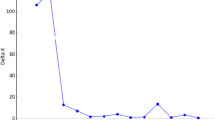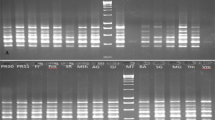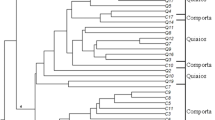Abstract
Fifteen species and eight cultivars of the section Pelargonium (DC.) Harv., two species of the section Ligularia (Sweet) Harv. and three species of the section Cortusina (DC.) Harv. were tested for genetic distance to predict successful combinations of interspecific crossings. 156 randomly amplified polymorphic DNA (RAPD)-bands and 485 double primer RAPD-bands were used for distance analysis. Combined with information on the ploidy level, species were clustered in the expected sections except Pelargonium hirtum (Burm. f.) Jacq., which clustered with the species of the section Cortusina. Different accessions of the same wild species showed a high conformity (67–98 %) comparable to the cultivars (66–70 %).

Similar content being viewed by others
References
Albers F, van der Walt JJA (1984) Untersuchungen zur Karyologie und Mikrosporogenese von Pelargonium sect. Pelargonium (Geraniaceae). Plant Syst Evol 147:177–188
Albers F, Gibby M, Austmann M (1992) A reappraisal of Pelargonium sect. Ligularia (Geraniaceae). Plant Syst Evol 179:257–276
Albers F, van der Walt JJA, Marais EM, Gibby M, Marschewski DE, van der Merwe AM, Bakker FT, Culham A (2000) A biosystematics study of Pelargonium section Ligularia: 4. The section Ligularia sensu stricto. S African J Bot 66:31–43
Bakker FT, Hellbrügge D, Culham A, Gibby M (1998) Phylogenetic relationships within Pelargonium sect. Peristera (Geraniaceae) inferred from nrDNA and cpDNA sequence comparisons. Plant Syst Evol 211:273–287
Bakker FT, Culham A, Daugherty LC, Gibby M (1999a) A trnL-F based phylogeny for species of Pelargonium (Geraniaceae) with small chromosomes. Plant Syst Evol 216:309–324
Bakker FT, Culham A, Gibby M (1999b) Phylogenetics and diversification in Pelargonium. In: Hollingsworth P, Bateman R, Gornall R (eds) Molecular systematics and plant evolution. Chapman and Hall, London, pp 353–374
Bakker FT, Culham A, Pankhurst CE, Gibby M (2000) Mitochondrial and chloroplast DNA based phylogeny of Pelargonium (Geraniaceae). Am J Bot 87:727–734
Bakker FT, Culham A, Hettiarachi P, Touloumenidou T, Gibby M (2004) Phylogeny of Pelargonium (Geraniaceae) based on DNA sequences from three genomes. Taxon 53:17–28
Bakker FT, Culham A, Marais EM, Gibby M (2005) Nested radiation in Cape Pelargonium. In: Bakker FT, Chatrou LW (eds) Plant species-level systematics: new perspectives on pattern and process. Koeltz Scientific Books, Koenigstein, pp 75–100
Becker M, Albers F (2009) Taxonomy and phylogeny of two subgroups of Pelargonium section Otidia (Geraniaceae). 1. The Pelargonium carnosum complex. Bothalia 39:73–85
Brawner F (2003) Geraniums. The complete encyclopedia. Schiffer Publishing Ltd., Atglen, pp 63–66 (pp. 82–102)
Coetzee N, van der Walt JJA, Marais EM (1994) The identity of a natural hybrid of Pelargonium (Geraniaceae). S Afr J Bot 60:1–4
Daker MG (1969) Chromosome numbers of Pelargonium species and cultivars. J Roy Hort Soc 94:346–353
Dreyer LL, Albers F, van der Walt JJA, Murschewski DE (1992) Subdivision of Pelargonium sect. Cortusina (Geraniaceae). Plant Syst Evol 183:83–97
Foden W, Potter L (2009) Pelargonium crispum (P.J. Bergius) L’Hér. National assessment: red list of South African plants version 2015.1. http://redlist.sanbi.org/species.php?species=1976-91. Accessed 23 Mar 2016
Gauger W (1937) Ergebnisse einer zytologischen Untersuchung der Familie der Geraniaceae. I. Planta 26:529–531
Gibby M (1990) Karyological studies in Pelargonium sectt. Ciconium, Dibrachya, and Jenkinsonia (Geraniaceae). Plant Syst Evol 170:151–159
Gibby M, Westfold J (1986) A cytological study of Pelargonium sect. Eumorpha (Geraniaceae). Plant Syst Evol 153:205–222
Horn W (1994) Interspecific crossability and inheritance in Pelargonium. Plant Breed 113:3–17
Jones CS, Martinez-Cabera HI, Nicotra AB, Mocko K, Marais EM, Schlichting CD (2013) Phylogenetic influences on leaf trait integration in Pelargonium (Geraniaceae): convergence, divergence and historical adaption to rapidly changing climate. Am J Bot 100:1306–1321
Kakihara F, Kato M, Tokumasu S (1987) Mechanism of selective development of ovules in Pelargonium, through the observation of pistils in non-pollinated flowers. Acta Hortic 215:139–144
Kato M, Tokumasu S (1983) Characteristics of F1 hybrids produced by ovule-culture in ornamental Pelargonium. Acta Hortic 131:247–252
Knicely WW (1964) Chromosome numbers and crossability studies in the genus Pelargonium. MSc. Thesis Pennsylvania State University, pp 1–156. In: Coffin JL, Harney PM (1978) Intersubgeneric crosses within genus Pelargonium. Euphytica 27:567–576
Knuth R (1912) Geraniaceae. In: Engler A (ed) Das Pflanzenreich IV.129, Berlin, pp 1–640
Meister A, Barow M (2007) DNA base composition of plant genomes. In: Dolozel J, Greilhuber J, Suda J (eds) Flow cytometry with plant cells. Wiley-VCH, Weinheim, pp 177–215
Motohashi T, Amano M (1986) Chromosome numbers of the genus Pelargonium (preliminary report). Sci Rep Res Inst Evol Biol 3:157–170
Nei M, Li WH (1979) Mathematical model for studying genetic variation in terms of restriction endonucleases. Proc Natl Acad Sci USA 76:5269–5273
Obermayer R, Greilhuber J (2006) Cryptopolyploidy revisited: the case of Vinca (Apocynaceae). Plant Syst Evol 256:201–208
Olbricht K (2013) Klonzüchtung ausgewählter gärtnerischer Kulturen unter dem Aspekt der Nachhaltigkeit, Habilitation-Thesis, Humboldt-Universität zu Berlin, pp 77–93
Plaschil S, Schrader O, Budahn H, Olbricht K, Hofmann C (2012) Enhancement of the genetic diversity in Pelargonium (section Pelargonium) by species introgression. Acta Hortic 953:155–160
Plaschil S, Budahn H, Schrader O, Olbricht K, Wiedemann M, Hofmann C (2015) Tetraploid male fertile Pelargonium crispum hybrids and their use in interspecific hybridization. Acta Hortic 1087:345–350
Porebski S, Bailey GL, Baum BR (1997) Modification of a CTAB DNA extraction protocol for plants with high polysaccaride and polyphenole contents. Plant Mol Biol Rep 15:8–15
Raimondo D, von Staden L, Foden W, Victor JE, Helme NA, Turner RC, Kamundi DA, Manyama PA (2009) Red List of South African Plants. South African National Biodiversity Institute, Pretoria
Röschenbleck J, Albers F, Müller K, Weinl S, Kulda J (2014) Phylogenetics, character evolution and subgeneric revision of the genus Pelargonium (Geraniaceae). Phytotaxa 159:31–76
Touloumenidou T, Bakker FT, Marais EM, Albers F (2004) Chromosomal evolution interpreted from rDNA ITS phylogeny for Pelargonium sect. Hoarea (Geraniaceae). Schumannia 4 (Biodiv and Ecol 2):93–106
van der Walt JJA (1979) Pelargonien des südlichen Afrikas, 2nd edn. Fischer, Hillscheid, p 12
van der Walt JJA, Roux JP (1991) Taxonomy and phylogeny of Pelargonium section Campylia (Geraniaceae). S African J Bot 57:291–293
van der Walt JJA, Vorster PJ (1983) Pelargoniums of Southern Africa, vol 2. Juta and Co Ltd, Cape Town, Johannesburg (pp vii, pp 69–70)
van der Walt JJA, Vorster PJ (1988) Pelargoniums of Southern Africa, vol 3. National Botanic Gardens Kirstenbosch, Cape Town, pp 37–38
van der Walt JJA, Albers F, Gibby M (1990) Delimitation of Pelargonium sect. Glaucophyllum (Geraniaceae). Plant Syst Evol 171:15–26
Volschenk B, van der Walt JJA, Vorster PJ (1982) The subspecies of Pelargonium cucullatum (Geraniaceae). Bothalia 14:45–51
Welsh J, McClelland M (1991) Genomic fingerprinting with AP-PCR using pairwise combination of primers: application to genetic mapping of the mouse. Nucleic Acids Res 19:5275–5279
Weng ML, Ruhlman TA, Gibby M, Jansen RK (2012) Phylogeny, rate variation, and genome size evolution of Pelargonium (Geraniaceae). Mol Phyl Ev 64:654–670
Williams JKG, Kubelik AR, Livak KJ, Rafalski JA, Tingey SV (1990) DNA polymorphisms amplified by arbitrary primers are useful as genetic markers. Nucleic Acids Res 18:6531–6535
Williams CA, Newmann M, Gibby M (2000) The application of leaf phenolic evidence for systematic studies within the genus Pelargonium (Geraniaceae). Biochem Syst Ecol 28:119–132
Yu SN, Horn WAH (1988) Additional chromosome numbers in Pelargonium (Geraniaceae). Plant Syst Evol 159:165–171
Acknowledgments
The authors wish to thank Martina Fuß for the technical and Annette Benecke for the horticultural assistance. Moreover, we thank Kühne-Jungpflanzen, Claus Kühne GbR, Dresden and Günter Schumann, the director of the institute in Quedlinburg, for supporting this project.
Author information
Authors and Affiliations
Corresponding author
Ethics declarations
Conflicts of interest
The authors declare that they have no conflict of interest.
Rights and permissions
About this article
Cite this article
Plaschil, S., Budahn, H., Wiedemann, M. et al. Genetic characterization of Pelargonium L’Hér. germplasm. Genet Resour Crop Evol 64, 1051–1059 (2017). https://doi.org/10.1007/s10722-016-0424-x
Received:
Accepted:
Published:
Issue Date:
DOI: https://doi.org/10.1007/s10722-016-0424-x




